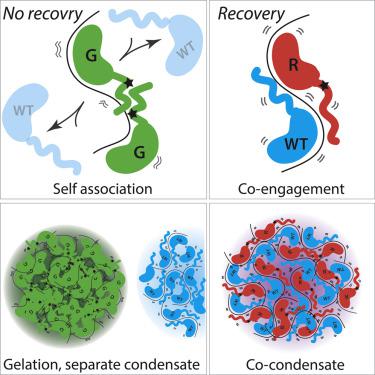Molecular Cell ( IF 14.5 ) Pub Date : 2020-11-06 , DOI: 10.1016/j.molcel.2020.10.014 Kevin Rhine 1 , Monika A Makurath 2 , James Liu 3 , Sophie Skanchy 4 , Christian Lopez 5 , Kevin F Catalan 1 , Ye Ma 6 , Charlotte M Fare 7 , James Shorter 7 , Taekjip Ha 8 , Yann R Chemla 9 , Sua Myong 10

|
The RNA-binding protein fused in sarcoma (FUS) can form pathogenic inclusions in neurodegenerative diseases like amyotrophic lateral sclerosis (ALS) and frontotemporal lobar dementia (FTLD). Over 70 mutations in Fus are linked to ALS/FTLD. In patients, all Fus mutations are heterozygous, indicating that the mutant drives disease progression despite the presence of wild-type (WT) FUS. Here, we demonstrate that ALS/FTLD-linked FUS mutations in glycine (G) strikingly drive formation of droplets that do not readily interact with WT FUS, whereas arginine (R) mutants form mixed condensates with WT FUS. Remarkably, interactions between WT and G mutants are disfavored at the earliest stages of FUS nucleation. In contrast, R mutants physically interact with the WT FUS such that WT FUS recovers the mutant defects by reducing droplet size and increasing dynamic interactions with RNA. This result suggests disparate molecular mechanisms underlying ALS/FTLD pathogenesis and differing recovery potential depending on the type of mutation.
中文翻译:

FUS 甘氨酸残基中的 ALS/FTLD 相关突变导致凝胶化加速并减少与野生型 FUS 的相互作用
肉瘤 (FUS) 中融合的 RNA 结合蛋白可在肌萎缩侧索硬化症 (ALS) 和额颞叶痴呆 (FTLD) 等神经退行性疾病中形成致病性包涵体。 Fus中超过 70 种突变与 ALS/FTLD 有关。在患者中,所有Fus突变都是杂合的,表明尽管存在野生型 (WT) FUS,但突变体仍会驱动疾病进展。在这里,我们证明甘氨酸(G)中的 ALS/FTLD 连接的 FUS 突变显着驱动不易与 WT FUS 相互作用的液滴的形成,而精氨酸(R)突变体与 WT FUS 形成混合缩合物。值得注意的是,WT 和 G 突变体之间的相互作用在 FUS 成核的最早阶段是不利的。相比之下,R 突变体与 WT FUS 发生物理相互作用,使得 WT FUS 通过减小液滴尺寸并增加与 RNA 的动态相互作用来恢复突变体缺陷。这一结果表明 ALS/FTLD 发病机制存在不同的分子机制,并且根据突变类型的不同,恢复潜力也不同。











































 京公网安备 11010802027423号
京公网安备 11010802027423号